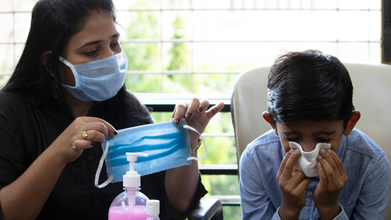- Health Conditions A-Z
- Health & Wellness
- Nutrition
- Fitness
- Health News
- Ayurveda
- Videos
- Medicine A-Z
- Parenting
Letting Kids 'Play Around' Is Actually Good For Them- Here's Why

Letting Kids 'Play Around' Is Actually Good For Them- Here's Why
When I met my friend Aishwarya's daughter, Aanya, on a Sunday afternoon, she was building an entire world in her backyard using only sticks, leaves, and her imagination. In her eyes, a stick became a magic wand, leaves turned into currency for her "shop," and an old cardboard box was her fortress. Aishwarya admitted that this was Aanya’s “free play” time—a period without gadgets, instructions, or adult guidance, which made me curious.
To put this to rest, we had a word with Dr Kushal Agrawal, Neonatologist and Head of the Department of Neonatology and Paediatrics at KVR Hospital Kashipur, "Unstructured play is much more than just frivolous fun. It is an integral part of child development. Today, children do not have much scope for free play. With the academic system, straddled by extracurricular activities and digital entertainment, the scope for unstructured play is getting smaller and smaller.". On the contrary, research reveals that unstructured plays hold a lot of benefits for children that structured activities may not have in store.
What are the Physical Benefits of Unstructured Play?
According to Dr Agrawal, "free time plays" are a great way for kids to get involved in physical activities meant for their growth. "When children are left to play freely, their movements become more varied and spontaneous," he says. Science behind this practice does support this because free play increases the levels of physical activity, which is moderately vigorous in children; this is essential in preventing childhood obesity and promoting health in general.
Other than these, the outdoor environments provide opportunities and challenges for natural development outside. While children run, jump, climb, and look around the outdoors, they can become able to develop strength, coordination, and endurance for a healthy and active lifestyle by exercising. Otherwise, structured activities often restrict children to specific movements or instructions.
How Play helps in Social and Emotional Growth of Kids?
Except for physical fitness, disorganized play lays the foundation for basic social and emotional capabilities. During unorganized play, children invent their games, negotiate roles, settle disputes, and collaborate to attain some common objectives. According to Dr. Agrawal, "such interactions build empathy, cooperation, and communication skills as children learn to express themselves, listen to others and adapt to group dynamics.".
Research indicates that children learn emotional resilience through unstructured play, navigating minor setbacks in a low-stakes environment. If the game goes sour, kids learn to solve the problem on the spot; this builds up their self-confidence as well as independence. This is a kind of play that gives children the freedom to learn by themselves and try new things without having the fear of being prohibited by others or the fear of failure.
How Parents can Encourage Creativity and Problem-Solving in Children
Freedom in play helps unlock a child's creativity and the problem-solving aspects. Most structured activities have predetermined tasks or instructions that do not develop creative thought. According to Dr Agrawal, "When children are allowed to be free, they can explore and create their own scenarios, which are meant for developing unique solutions based on critical thinking.".
Unstructured play provides children with a number of materials for play—blocks, sand, or leaves, for example—without script, so that they invent games, build imaginary worlds, and, in a very real sense, answer their natural curiosity. It has been proven that this type of play helps children to make decisions, adaptability, and innovations, qualities useful throughout life.
Is Play Holistic Approach to Child Development?
Dr Agrawal believes that unstructured play is a very important factor of all-rounded child development. "Nowadays, children's lives are very scheduled, so it's very important for the parents to remember how necessary play is", he further adds. Being freely playful would be a great support to their healthy physical development as well as social, emotional, and cognitive development.
As parents, we can encourage free play by creating an environment that encourages exploration and curiosity. What can be very impactful is giving the child a safe outdoor space and setting aside gadgets to allow for uninterrupted time to play. As these spaces tend to be counterintuitive to everything that can be seen as a hallmark of productivity and measurable progress, unstructured play allows the children to build resilience, independence, and joy.
Giving Children the Freedom to Play
More than just being childhood, unstructured play confers a wide range of benefits since children learn to manage social dynamics, solve problems independently, and bring their creativity into life which puts them better prepared for the challenges of adulthood. In this natural form of play, people lay down a foundation for lifelong skills to achieve balanced wellbeing and success.
The next time you catch your child playing carefree—maybe using a stick as a wand or a rock as a pet—take the time to be thankful for the developmental steps.
Baby Born From Liver? Pregnant Woman In Peru Delivers A Child Through Ectopic Pregnancy

Credits: Canva
A 16-year-old mother in Peru delivered a baby who was in placenta that attached to her liver.
This is a rare milestone as the baby has been safely delivering from an abdominal ectopic pregnancy in which the placenta was attached to the mother’s liver.
The case involved 19 year old Valeria Vela, whose pregnancy continued to 40 weeks and resulted in the birth of a healthy baby girl. Health authorities in Peru say this is the first documented case of its kind in the country and only the fourth reported worldwide in which both mother and baby survived.
Understanding the Rarity of Ectopic Pregnancies
Ectopic pregnancies occur when a fertilized egg implants outside the uterus. In most situations, they develop in the fallopian tubes.
Around 96 percent of ectopic pregnancies happen there and only a very small number occur in the abdominal cavity. These pregnancies cannot safely continue because the organs where the egg may attach are not designed to support a growing fetus. In this case, the egg implanted directly on the liver, which meant the fetus relied on the liver’s arteries for blood supply. This created a situation that demanded extremely careful monitoring, as even small shifts in blood flow could have been dangerous.
The Challenges Doctors Faced
For doctors, the biggest challenge was the placenta. Removing a placenta that has attached itself to the liver can cause severe bleeding that can quickly turn fatal. Peru’s Health Minister Luis Quiroz Avilés explained that any attempt to detach it without preparation could have caused life threatening hemorrhage in the mother.
To manage this, the medical team used a technique that closes the arteries feeding the placenta by blocking their blood flow. This approach helped prevent massive bleeding during surgery and gave both mother and baby a chance at survival.
Another extraordinary aspect of this case was that the pregnancy reached 40 full weeks. Previous live abdominal ectopic pregnancies that resulted in birth reached only up to 36 weeks. Doctors followed Valeria closely through her pregnancy and relied on advanced imaging and interventional radiology techniques to keep the situation stable. According to local reports, the clinical management required constant coordination among specialists from obstetrics, radiology, surgery and intensive care.
A Baby Born Against All Odds
The baby, named Aylin, was born on November 30 and weighed 7.9 pounds. Officials revealed the case only after both mother and child were safely discharged from the hospital. Valeria is now in stable condition and recovering well, while Aylin is reported to be healthy.
Why This Does Not Change Standard Care
Although the case has been described as a medical milestone, specialists emphasize that such pregnancies are exceptionally rare. Most ectopic pregnancies cannot continue and trying to carry them comes with severe risks that include hemorrhage, organ damage and even death. For this reason, early diagnosis and timely intervention remain the safest and most widely recommended approach. This case highlights what is medically possible under very specific circumstances, but it does not change established guidelines for managing ectopic pregnancies.
Is There A Link Between Social Media Use And Increased ADHD-Like Symptoms In Kids?

Credits: Canva
Do you feel like your attention span has gone down? Thanks to multiple social media platforms and its shorter duration content, we find ourselves losing attention and cannot keep up with anything that goes a little bit over a minute. This has not just affected us, but children are now being diagnosed with attention deficit hyperactivity disorder (ADHD) more.
A latest peer-reviewed study by Karolinska Institutet, which monitored more than 8,300 US-based children from age of 10 to 14 noted that social media use has lead to increased inattention symptoms.
The researchers of the aforementioned institute in Sweden, along with the Oregon Health & Science University in the US found that children spent an average of 2.3 hours a day watching television or online videos, 1.4 hours on social media and 1.5 hours playing video games.
The study found no connection between ADHD-related behaviors, such as distractibility, and activities like playing video games or watching TV and YouTube. However, long-term social media use was linked to rising inattention symptoms in children. ADHD is a neurodevelopmental condition marked by impulsiveness, trouble focusing and frequently forgetting everyday tasks.
. According to the researchers, “We identified an association between social media use and increased inattention symptoms, interpreted here as a likely causal effect.” They noted that while the impact on each child may be small, widespread behavioral shifts could have a meaningful effect at the population level. The study also suggested that growing social media use may be contributing to the rise in ADHD diagnoses.
Why Social Media May Disrupt Focus
Torkel Klingberg, a professor of cognitive neuroscience at the Karolinska Institute, said the findings pointed specifically to social media as a factor affecting children’s ability to concentrate. He explained that platforms bombard users with constant notifications and messages, and even the anticipation of receiving one can interrupt mental focus. “This affects the ability to stay focused and could explain the association,” he said.
The research also showed that socioeconomic background and genetic risk for ADHD did not change the observed link, suggesting that the distraction-rich environment of social media itself may be responsible. Klingberg added that increasing social media use could partly explain the rise in ADHD diagnoses among children, which grew from 9.5 percent in 2003–07 to 11.3 percent in 2020–22, based on data from the U.S. National Survey of Children’s Health.
Early Social Media Exposure Raises Concerns
The authors stressed that the study does not imply all children who use social media will develop concentration problems. However, they pointed out that many children begin using these platforms well before age 13, the minimum age for apps such as Instagram and TikTok. The report called for stronger age verification measures and clearer guidance from tech companies.
How Much Time Children Spend Online
The study tracked a gradual rise in social media use, from around 30 minutes a day at age nine to about two and a half hours by age 13. The children were enrolled at ages nine and ten between 2016 and 2018. The full findings will appear in the journal Pediatrics Open Science.
Samson Nivins, a postdoctoral researcher at the Karolinska Institute and one of the study’s authors, said the team hopes the results will help parents and policymakers make more informed decisions about healthy digital habits that support children’s cognitive development.
Why A Persistent Cough In Children Needs Attention, And Ways To Strengthen Their Immunity, According To Doctor

Credits: iStock
As winter settles in and children move between school, outdoor play, and indoor gatherings, coughs and colds often become unavoidable companions. While many coughs resolve on their own, doctors warn that a cough that lingers for weeks is not something parents should overlook. At the same time, the cold season naturally weakens a child’s defenses, making it important for families to follow simple steps to improve immunity.
When a Cough Lasts Too Long
According to Dr Nishant Bansal, Consultant Pediatrician and Neonatologist at Motherhood Hospitals, Noida, parents must stay alert when a cough stretches beyond the usual duration. He explains, “A cough that lasts for weeks should never be ignored. While many are caused by mild infections, persistent or recurring coughs can point to allergies, asthma, or an underlying health issue.”
Many children are catching respiratory infections during weather changes or after starting school. As temperatures drop, coughs tend to worsen. What may look like a harmless lingering cold could actually be linked to an allergy, asthma, sinusitis, whooping cough, or even exposure to pollutants and smoke.
Dr Bansal adds, “If a child’s cough becomes worse at night, during exercise, or after exposure to dust or pets, it may be triggered by asthma or allergies. These symptoms should be reported to a doctor without delay.” Children exposed to polluted air or cigarette smoke are especially prone to constant coughing and wheezing.
Ignoring these symptoms can interfere with sleep, appetite, growth, and energy levels. Some infections, such as whooping cough or sinusitis, require prompt treatment to prevent complications. That is why early identification of the cause is essential.
Managing and Preventing Persistent Coughs
Parents often try repeated home remedies such as honey, steam, or warm fluids, but these may not be enough. “If the cough lasts more than two to three weeks, it should be evaluated instead of being managed with only home remedies,” says Dr Bansal.
Indoor air quality plays a major role. Avoid smoking around children, improve ventilation, and use an air purifier if possible. Keeping children well hydrated with warm soups, milk, or water can soothe the throat and loosen mucus. Over the counter cough syrups should be avoided unless a doctor prescribes them.
Warning signs such as wheezing, breathing difficulty, coughing fits, or fever need immediate medical care. Timely guidance helps the child breathe better, recover faster, and avoid long term complications.
Why Winter Increases Illnesses in Children
Children are naturally more vulnerable during colder months. They often face sore throats, colds, coughs, and viral infections that spread easily when people gather indoors. Dr Atul Palwe, Consultant Pediatrician and Neonatologist at Motherhood Hospital, Lullanagar, Pune, explains, “Viruses spread more easily in winter, especially when children stay in closed spaces for long hours.”
Strengthening immunity is key to helping children stay healthy throughout the season.
Simple Ways to Boost a Child’s Immunity
Focus on a Nutritious Diet
“A strong immune system begins with a balanced diet,” says Dr Palwe. He recommends plenty of fruits, vegetables, whole grains, legumes, nuts, and seeds. Foods rich in vitamin C such as oranges, guavas, and amla, along with zinc and iron rich foods, help build resistance.
Maintain Hydration
Children tend to drink less water in winter, but staying hydrated helps the body remove toxins. Warm soups and milk are comforting alternatives.
Encourage Regular Activity
Indoor games, yoga, and outdoor play on pleasant days improve blood circulation and strengthen immunity.
Ensure Adequate Sleep
“Children under ten need about ten to twelve hours of sleep every night to keep their immunity strong,” says Dr Palwe.
Teach Hygiene Habits
Handwashing before meals, after play, and covering the mouth while coughing reduces the spread of infections.
Dress Them Warmly
Layering helps protect children from cold winds while still allowing movement.
Get Enough Vitamin D
Limited sunlight in winter can affect vitamin D levels. Dr Palwe suggests encouraging morning outdoor play or discussing supplements with a doctor if needed.
© 2024 Bennett, Coleman & Company Limited

